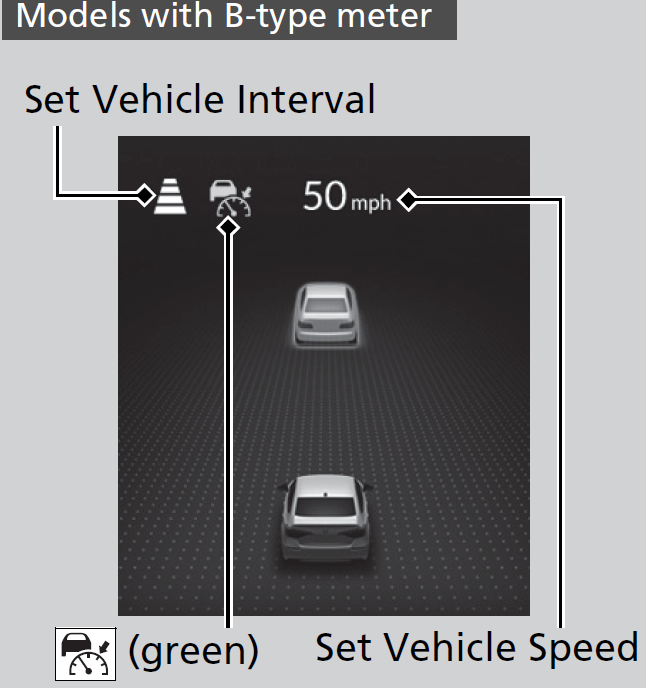Adaptive Cruise Control (ACC)*
When ACC slows your vehicle by applying the brakes, your vehicle’s brake lights will illuminate.

- WARNING
- Improper use of ACC can lead to a crash.
Use ACC only when driving on expressways or freeways and in good road and weather conditions.
- WARNING
- ACC has limited braking capability.
When your vehicle speed drops below 22 mph (35 km/h), ACC will automatically cancel and no longer will apply your vehicle’s brakes.
Always be prepared to apply the brake pedal when conditions require.
- Detail
-
Important ReminderAs with any system, there are limits to ACC. Use the brake pedal whenever necessary, and always keep a safe interval between your vehicle and other vehicles.You can read about handling information for the camera equipped with this system.
ACC may not work properly under certain conditions.
When the engine speed slows down, try to downshift. When the engine speed goes up, try to upshift. You can maintain the set speed if you change gear within five seconds.When not using ACC: Turn off adaptive cruise by pressing the button.Do not use ACC under the following conditions:
button.Do not use ACC under the following conditions:- On roads with frequent lane-change or continuous stop and go traffic. ACC cannot keep an appropriate distance between your vehicle and vehicle ahead of you.
- On roads with sharp turns.
- On roads with toll collection facilities or other objects between lanes of traffic, or in parking areas, or facilities with drive through access.
- On roads with bad weather (rain, fog, snow, etc.), ACC may not detect the distance between your vehicle and the vehicle ahead of you properly.
- On roads with slippery or icy surfaces. The wheels may spin out and your vehicle may lose the control on the condition.
- On roads with steep uphill or steep downhill slopes.
- On roads with undulating slopes.
How to activate the system

To Set the Vehicle Speed

Take your foot off the pedal and press the RES/+/SET/− switch up or down when you reach the desired speed. The moment you release the switch, the set speed is fixed, and ACC begins.
When you use ACC, Straight Driving Assist (a feature of the Electric Power Steering system) is activated.
By enabling the steering system to automatically compensate for natural steering pull, Straight Driving Assist makes it easier for you to keep your vehicle in a straight line.
- Models with A-type meter
- Models with B-type meter
When ACC starts operating, the vehicle icon, interval bars and set speed appear on the gauge.
-

- Detail
-
The Vehicle Stability AssistTM (VSA®) system, Vehicle Stability AssistTM (VSA®) OFF*, Adaptive Cruise Control (ACC), low tire pressure/TPMS* and safety support indicators may come on in amber along with a message in the gauge when you set the power mode to ON after reconnecting the battery.
Drive a short distance at more than 12 mph (20 km/h).
Each indicator should go off. If any do not, have your vehicle checked by a dealer.You can switch the displayed set speed measurements on the driver information interface or audio/information screen between mph and km/h.
Speed/Distance Units (Driver Information Interface (A-type Meter))
Speed/Distance Units (Driver Information Interface Right Side Area (B-type Meter))
When in Operation
- Detail
-
If the vehicle ahead of you slows down abruptly, or if another vehicle cuts in front of you, a beeper sounds, a message appears on the driver information interface.
 Depress the brake pedal, and keep an appropriate interval from the vehicle ahead.
Depress the brake pedal, and keep an appropriate interval from the vehicle ahead.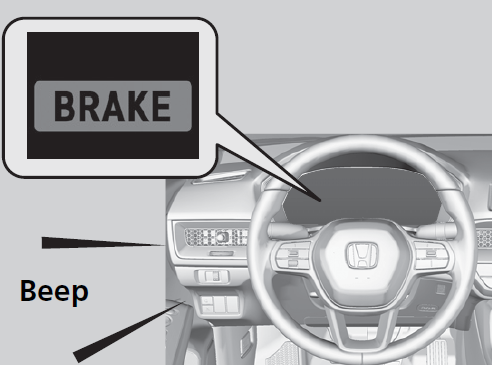 Even if the interval between your vehicle and the vehicle detected ahead is short, ACC may start accelerating your vehicle under the following circumstances:
Even if the interval between your vehicle and the vehicle detected ahead is short, ACC may start accelerating your vehicle under the following circumstances:- The vehicle ahead of you is going at almost the same speed as, or faster than, your vehicle.
- A vehicle that cuts in front of you is going faster than your vehicle, gradually increasing the interval between the vehicles.
You can also set the system to beep when a vehicle in front of you comes in and goes out of the ACC detecting range. A vehicle detect beep on and off can be selected.
LimitationsYou may need to use the brake to maintain a safe interval when using ACC. Additionally, ACC may not work properly under certain conditions.
- ACC may temporarily control the interval between your vehicle and the vehicle in adjacent lane or surroundings of your vehicle depending on the road conditions (e.g., curves) or vehicle conditions (e.g., operating the steering wheel or the vehicle location in the lane).

- When the vehicle ahead of you moves away, such as when entering an interchange or rest area, ACC may continue to maintain the set following-interval for a short time.
There is a vehicle ahead
ACC monitors if a vehicle ahead of you enters the ACC range. If a vehicle is detected doing so, the ACC system maintains or decelerates your vehicle’s set speed in order to keep the vehicle’s set following-interval from the vehicle ahead.
To Set or Change Following-interval

-
When a vehicle whose speed is slower than your set speed is detected in front of you, your vehicle starts to slow down.
-

There is no vehicle ahead
- Your vehicle maintains the set speed without having to keep your foot on the brake or accelerator pedal.
If there previously was a vehicle detected ahead that kept your vehicle from traveling at the set speed, ACC accelerates your vehicle to the set speed, and then maintains it.While driving down steep hills, ACC brakes to inhibit excessive acceleration for maintaining the set speed.
However, the vehicle speed may become faster than the set speed. -

When you depress the accelerator pedal
You can temporarily increase the vehicle speed. In this case, there is no audible or visual alert even if a vehicle is in the ACC range.ACC stays on unless you cancel it. Once you release the accelerator pedal, the system resumes the set speed.
There are times when the vehicle speed will decrease when the accelerator pedal is lightly applied.
ACC Conditions and Limitations
The system may automatically shut off under certain conditions. Some examples of these conditions are listed below. Other conditions may reduce some of the ACC functions.
Environmental conditions
- Driving in bad weather (rain, fog, snow, etc.).
- Sudden changes between light and dark, such as the entrance or exit of a tunnel or the shadows of trees, buildings, etc.
- Strong light is reflected onto vehicles or road surfaces.
- Water is sprayed by or snow blown from a vehicle ahead.
- Driving at night or in a dark place such as a tunnel (due to low-light conditions, the whole vehicle may not be illuminated).
- Driving into low sunlight (e.g., at dawn or dusk).
Roadway conditions
- Driving on curvy, winding, undulating, or sloping roads.

- Driving on rutted roads (snowy or unpaved roads, etc.).
- Puddles or a film of water is on the road surface.
- Your vehicle is strongly shaken on uneven road surfaces.
Vehicle conditions
- The vehicle is tilted due to heavy load in the trunk or rear seats.
- Tire chains are installed.
- The front of the camera is covered by dirt, fog, rain, mud, wet snow, seals, accessories, stickers, or film of the windshield.
- Driving at night or in a dark place (e.g., a tunnel) with the headlights off.
- There is residue on the windshield from the windshield wipers.
- When lighting is weak due to dirt covering the headlight lenses, or there is poor visibility in a dark place due to the headlights being improperly adjusted.
- An abnormal tire or wheel condition (incorrect sizes, varied sizes or construction, improperly inflated, compact spare tire*, etc.).
- The suspension has been modified.
Examples of conditions under which the camera may not correctly detect the vehicle ahead of you
- A vehicle suddenly crosses in front of you.
- The interval between your vehicle and the vehicle ahead of you is too short.
- When the vehicle ahead of you blends in with the background, preventing the system from recognizing it.
- The headlights of the vehicle ahead of you are lit on one side or not lit on either side in a dark place.
Examples of conditions under which the system may not work properly
- A vehicle ahead of you stops and the speed difference between your vehicle and the vehicle ahead of you is significantly large.
- When the vehicle ahead of you slows suddenly.
- When a vehicle ahead of you is specially-shaped.
- When a vehicle is lower in the rear than the front such as trucks that are not carrying a load, or a narrow vehicle.

- When your vehicle or the vehicle ahead of you is driving on the edge of the lane.
- When the vehicle ahead of you is a narrow vehicle such as a motorcycle.
- When the minimum ground clearance of a vehicle ahead of you is extremely high.

- When the camera cannot correctly identify the shape of the vehicle ahead of you.
To Adjust the Vehicle Speed
Increase or decrease the vehicle speed using the RES/+/SET/−switch on the steering wheel.

- Each time you press the RES/+/SET/− switch up or down, the vehicle speed is increased or decreased by about 1 mph or 1 km/h accordingly.
- If you keep the RES/+/SET/− switch pressed up or down, the vehicle speed increases or decreases by about 5 mph or 5 km/h accordingly.
- Detail
-
If a vehicle detected ahead is going at a speed slower than your increased set speed, ACC may not accelerate your vehicle. This is to maintain the set interval between your vehicle and the vehicle ahead.When you depress the accelerator pedal and then press down and release the RES/+/SET/−switch, the current speed of the vehicle is set.
To Set or Change Following-interval
Press the Interval button to change the ACC following-interval.
Each time you press the button, the following-interval (the interval behind a vehicle detected ahead of you) setting cycles through furthest, far, mid, and nearest following-intervals.Determine the most appropriate following-interval setting based on your specific driving conditions. Be sure to adhere to any following-interval requirements set by local regulation.
-

The higher your vehicle’s following-speed is, the longer the nearest, mid, far or furthest following-interval becomes. See the following examples for your reference.
|
Following-interval
|
When the Set Speed is:
|
||
|---|---|---|---|
|
50 mph (80 km/h)
|
65 mph (104 km/h)
|
||
|
Nearest
|
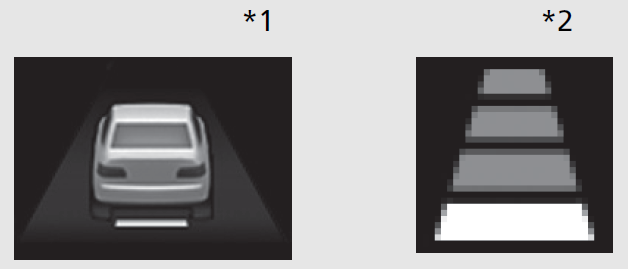 |
87.3 feet
26.6 meters
1.2 sec
|
110.6 feet
33.7 meters
1.2 sec
|
|
Mid
|
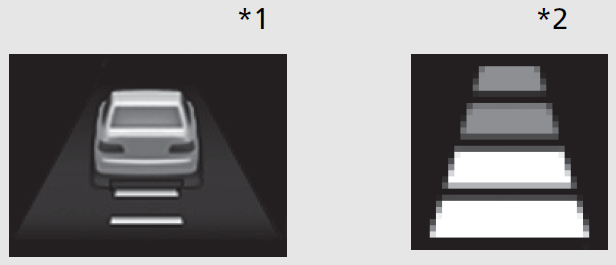 |
113.4 feet
34.6 meters
1.6 sec
|
147.2 feet
44.9 meters
1.6 sec
|
|
Far
|
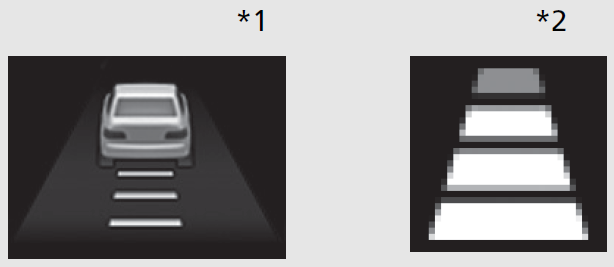 |
144.2 feet
44.0 meters
2.0 sec
|
187.3 feet
57.1 meters
2.0 sec
|
|
Furthest
|
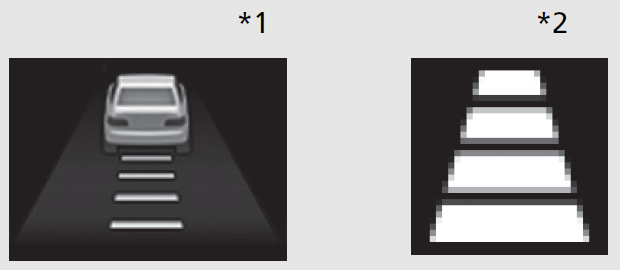 |
175.9 feet
53.6 meters
2.4 sec
|
229.6 feet
70.0 meters
2.4 sec
|
- Models with A-type meter
- Models with B-type meter
To Cancel
- To cancel ACC, do any of the following:
- Press the CANCEL button.
- The
 indicator (green) on the gauge changes to the
indicator (green) on the gauge changes to the  indicator (white).
indicator (white).
- The
- Press the
 button.
button. indicator (green) goes off.
indicator (green) goes off.
- Depress the brake pedal while the vehicle is moving forward.
- The
 indicator (green) on the gauge changes to the
indicator (green) on the gauge changes to the  indicator (white).
indicator (white).
- The
- Depress the clutch pedal for five seconds or more.
- The
 indicator (green) on the gauge changes to the
indicator (green) on the gauge changes to the  indicator (white).
indicator (white).
- The
- Press the CANCEL button.
-

- Detail
-
Resuming the prior set speed: After you have canceled ACC, you can activate the ACC with the prior set speed displayed on the gauge (in gray) by pressing the RES/+/SET/− switch up even if the vehicle is stopped.
When you turn the ACC off by pressing the CANCEL button or depressing the brake pedal, the prior set speed is displayed on the gauge in gray.
When pressing the RES/+/SET/− switch up, the ACC is activated with displayed speed.
If the indicator (white) is displayed and you press the RES/+/SET/− switch up, but no prior set speed (in gray) is displayed, the speed will be set to your vehicle's current speed.
indicator (white) is displayed and you press the RES/+/SET/− switch up, but no prior set speed (in gray) is displayed, the speed will be set to your vehicle's current speed.
The set speed cannot be set or resumed when ACC has been turned off using the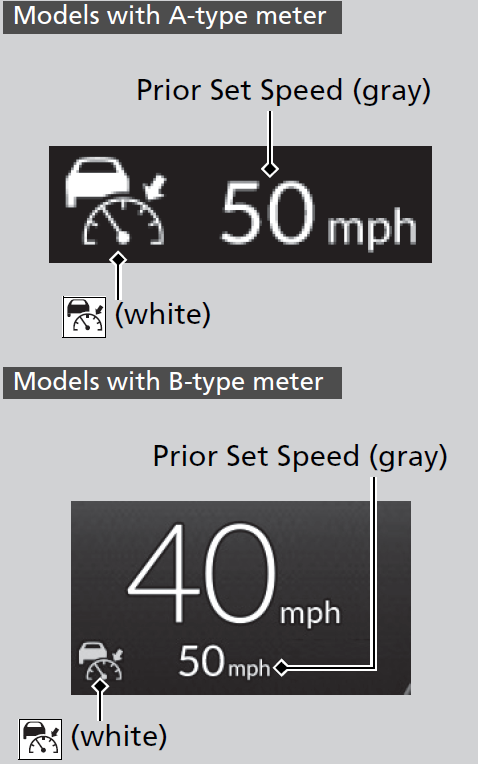
 button. Press the
button. Press the  button to activate the system, then set the desired speed.
button to activate the system, then set the desired speed.
If the vehicle speed is less than 25 mph (40 km/h) you cannot resume.
Automatic cancellation
The beeper sounds and a message appears on the driver information interface when ACC is automatically canceled. Any of these conditions may cause the ACC to automatically cancel:
- Bad weather (rain, fog, snow, etc.)
- The vehicle ahead of you cannot be detected.
- An abnormal tire condition is detected, or the tires are skidding.
- Driving on a mountainous road for extended periods, or driving off road.
- Abrupt steering wheel movement.
- When the ABS, VSA®, CMBSTM or Low Speed Braking Control* is activated.
- When the VSA® system indicator comes on.
- When the vehicle is stopped on a very steep slope.
- When you manually apply the parking brake.
- When vehicle speed is less than 22 mph (35 km/h).
- Water is sprayed by or snow blown from a vehicle ahead.
- Driving into low sunlight (e.g., at dawn or dusk).
- When the detected vehicle within the ACC range is too close to your vehicle.
- When accelerating rapidly.
- The front of the camera is covered by dirt, fog, rain, mud, wet snow, seals, accessories, stickers, or film on the windshield.
- The engine is turned off.
- The vehicle is loaded heavy load in the trunk or rear seats.
- When passing through a dark place, such as tunnel.
- When the parking brake and brake system indicator (amber) comes on.
- The vehicle has repeatedly applied the brakes to maintain the set speed (for example, you are descending a long slope).
- When the system doesn't detect any driving actions from the driver for a certain amount of time while the LKAS is also activated.
- Ignoring shift down indication shown in the gauge will cancel the ACC after about 10 seconds.
- The engine speed goes into the tachometer red zone.
- The engine speed goes to below 1,000 rpm.
- You shift into neutral temporarily when shifting into a higher or lower gear.
- When the transmission is put into N without depressing the clutch pedal.
To Switch ACC to Cruise Control
- Press and hold the Interval button for one second. Cruise mode selected appears on the driver information interface for two seconds, and then the mode switches to Cruise.
The indicator comes on.
indicator comes on.- Green: The system is on.
- White: The system is standby.
-

- Detail
-
Always be aware which mode you are in. When you are driving in Cruise mode, the system will not assist you to maintain a following-interval from a vehicle ahead of you.You cannot switch ACC to Cruise Control in the following situations:
- When the vehicle speed is set.
- When ACC is not activated.
You can switch the displayed set speed measurements on the driver information interface or audio/information screen between mph and km/h.
Speed/Distance Units (Driver Information Interface (A-type Meter))
Speed/Distance Units (Driver Information Interface Right Side Area (B-type Meter))
When to use
Desired speed in a range above roughly 25 mph (40 km/h).
To Set the Vehicle Speed
Take your foot off the pedal and press the RES/+/SET/− switch up or down when you reach the desired speed.The moment you release the RES/+/SET/− switch, the set speed is fixed, and cruise control begins. The color of
 indicator changes from white to green.
indicator changes from white to green.When you use cruise control, Straight Driving Assist (a feature of the Electric Power Steering system) is activated.
By enabling the steering system to automatically compensate for natural steering pull, Straight Driving Assist makes it easier for you to keep your vehicle in a straight line.
To Adjust the Vehicle Speed
- Each time you press the RES/+/SET/− switch up or down, the vehicle speed is increased or decreased by about 1 mph or 1 km/h accordingly.
- If you keep the RES/+/SET/− switch pressed up or down, the vehicle speed increases or decreases by about 5 mph or 5 km/h accordingly.
To Cancel
To cancel cruise control, do any of the following:
- Press the CANCEL button.
- The
 indicator (green) on the gauge changes to the
indicator (green) on the gauge changes to the  indicator (white).
indicator (white).
- The
- Press the
 button.
button.- The
 indicator (green) goes off.
indicator (green) goes off.
- The
- Depress the brake pedal.
- The
 indicator (green) on the gauge changes to the
indicator (green) on the gauge changes to the  indicator (white).
indicator (white).
- The
- Depress the clutch pedal for five seconds or more.
- The
 indicator (green) on the gauge changes to the
indicator (green) on the gauge changes to the  indicator (white).
indicator (white).
- The
- Detail
-
Resuming the prior set speed: After you have canceled cruise control, you can activate the cruise control with the prior set speed displayed on the gauge (in gray) by pressing the RES/+/SET/− switch up while driving at a speed of at least 25 mph (40 km/h) or more.
When you turn the cruise control off by pressing the CANCEL button or depressing the brake pedal, the prior set speed is displayed on the gauge in gray.
When pressing the RES/+/SET/− switch up, the cruise control is activated with displayed speed.
If the indicator (white) is displayed and you press the RES/+/SET/− switch up, but no prior set speed (in gray) is displayed, the speed will be set to your vehicle's current speed.
indicator (white) is displayed and you press the RES/+/SET/− switch up, but no prior set speed (in gray) is displayed, the speed will be set to your vehicle's current speed.
The set speed cannot be set or resumed when ACC has been turned off using the
 button. Press the
button. Press the  button to activate the system, then set the desired speed.If the vehicle speed is less than 25 mph (40 km/h) you cannot resume.
button to activate the system, then set the desired speed.If the vehicle speed is less than 25 mph (40 km/h) you cannot resume.
* Not available on all models

